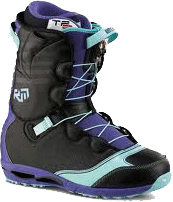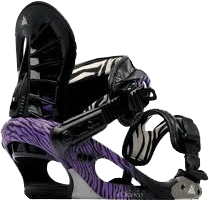Boarding Boots
Buying boarding boots is about the same as buying ski boots. You should try on every set of boots in the shop, then go to the next shop, and the next. Once you know what fits and what does not — then look at your short list again.
For The Newbie, there are two distinct types of boots - soft and hard (plastic). If you don't know this, you don't want plastic boots... as plastic boots go on a race board. Most boots are fairly durable. Like anything there are a lot of features you can look for. Boots can have two sets of laces (inner and outer) or a pull string on the inner. The toe and the heel of the boot can be tapered upward to prevent toe or heel drag. The amount of support can vary from boot to boot. Park oriented boots are normally a bit shorter around the ankles than free ride boots. Have a look at how tight you can get the boots around the your ankle.
Most boots are fairly durable. Like anything there are a lot of features you can look for. Boots can have two sets of laces (inner and outer) or a pull string on the inner. The toe and the heel of the boot can be tapered upward to prevent toe or heel drag. The amount of support can vary from boot to boot. Park oriented boots are normally a bit shorter around the ankles than free ride boots. Have a look at how tight you can get the boots around the your ankle.
The thing to remember is, — when you ride well - you ride though your feet as if you are standing on the board. So, like a normal pair of shoes, you should be looking for something which is comfortable to stand in as your first priority. What can aid in this greatly are a pair of footbeds, such as Superfeet (awesome, $30 to $40 typical). The last thing to look as is, are these boots going to fit into your bindings properly.
Bindings
Of course you want to choose bindings that fit your style, but finding the right combination of bindings and boots isn't always easy. Not all styles will work together. Here are the best combinations:

Soft Boots with Strap-On/Flow—In Bindings: This is the most flexible pairing: just about any pair of soft boots can fit into strap—on bindings. It also happens to be the most comfortable combo when you're not on your board. Freestylers and Freeriders, take note. Soft/Hard Step—In Boots with Step—In Bindings: Step—in boots are required for step—in bindings as the systems need to work together so it's easy to get on and off the board. However, your selection will be limited. Cheaper step—ins will also hinder your board control. Hard Boots with Plate/Lever Bindings: This will give you the most control over your board. Freecarvers will appreciate this the most since they need precision for high speed turns.
Boards
Of course you want to choose bindings that fit your style, but finding the right combination of bindings and boots isn't always easy. Not all styles will work together. Here are the best combinations:
Soft Boots with Strap-On/Flow—In Bindings: This is the most flexible pairing: just about any pair of soft boots can fit into strap—on bindings. It also happens to be the most comfortable combo when you're not on your board. Freestylers and Freeriders, take note. Soft/Hard Step—In Boots with Step-In Bindings: Step—in boots are required for step—in bindings as the systems need to work together so it's easy to get on and off the board. However, your selection will be limited. Cheaper step—ins will also hinder your board control. Hard Boots with Plate/Lever Bindings: This will give you the most control over your board. Freecarvers will appreciate this the most since they need precision for high speed turns.
It also happens to be the most comfortable combo when you're not on your board. Freestylers and Freeriders, take note. Soft/Hard Step—In Boots with Step-In Bindings: Step—in boots are required for step—in bindings as the systems need to work together so it's easy to get on and off the board. However, your selection will be limited. Cheaper step—ins will also hinder your board control. Hard Boots with Plate/Lever Bindings: This will give you the most control over your board. Freecarvers will appreciate this the most since they need precision for high speed turns.